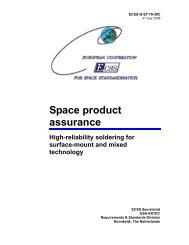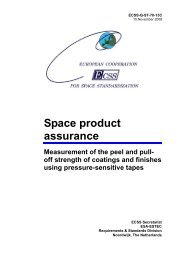ECSS-Q-70-03A (7 April 2006)
ECSS-Q-70-03A (7 April 2006)
ECSS-Q-70-03A (7 April 2006)
You also want an ePaper? Increase the reach of your titles
YUMPU automatically turns print PDFs into web optimized ePapers that Google loves.
<strong>ECSS</strong>-Q-<strong>70</strong>-<strong>03A</strong><br />
7 <strong>April</strong> <strong>2006</strong><br />
Black-anodizing conditions<br />
5.1 Specific equipment and environmental conditions<br />
5.2 Anodizing<br />
5.1.1 Facilities<br />
a. The work area shall be clean and free of dust. Air used for ventilation shall<br />
be filtered to prevent contamination of the workpieces by moisture, oil or<br />
dust.<br />
b. The environment shall fulfil the requirements of national health<br />
regulations. Individual protective equipment shall be used according to<br />
national health regulations.<br />
5.1.2 Surface preparation and cleaning<br />
a. A surface preparation treatment shall be performed on the part to be<br />
coated to remove any oil dust or other contaminants from the surface.<br />
b. Lint-free gloves or surgical latex talc-free gloves shall be worn when<br />
handling the parts.<br />
c. Other surface treatments can be applied to the part to, for example,<br />
improve the quality of the surface or increase its roughness.<br />
d. Masking can be applied to the parts not to be anodized.<br />
5.2.1 General<br />
In the electrochemical process, each part that is anodized needs electrical<br />
contact.<br />
a. The electrical contact shall be of a size compatible with the size of the<br />
hardware to be processed and with the process specifications.<br />
b. The location of the electrical contact shall be chosen not to interfere with<br />
the functional usage of the part to be treated.<br />
c. Depending on the exact electrochemical process used, specific parameters<br />
shall be controlled. Among those parameters are:<br />
1. composition and pH of the electrolyte,<br />
2. location of the electrodes and their distance with respect to the part,<br />
3. temperature of the bath,<br />
4. stirring of the bath,<br />
5. volume of the electrolyte with respect to that of the treated part, and<br />
6. process time.<br />
d. A record of the in-process data shall be part of the process procedure.<br />
5<br />
17
















